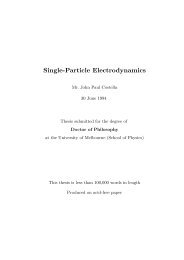HERF Data #3 - Assassination Science
HERF Data #3 - Assassination Science
HERF Data #3 - Assassination Science
Create successful ePaper yourself
Turn your PDF publications into a flip-book with our unique Google optimized e-Paper software.
INTRODUCTION<br />
BACKGROUND.<br />
Current Federal Aviation Administration (FAA) regulations require that aircraft systems and<br />
equipment operate as required in their intended environment. In recent years the advances and<br />
growth of radio communications and other electronic technologies have introduced into the<br />
operational environment a phenomena know as High-Intensity Radiated Fields (HIRF). There<br />
are more than 500,000 emitters in the U.S. and Western Europe contributing to the<br />
electromagnetic environment. Aircraft are exposed to the HIRF environments that emanate from<br />
high-powered radio and television frequency transmitters, radar and satellite uplink transmitters,<br />
and large microwave communications systems. Electrical and electronic systems are fast<br />
replacing mechanical devices to perform functions in aircraft flight and navigation systems that<br />
are necessary for the continued safe flight and landing of the aircraft. Basic functions such as<br />
engines and flight controls may be inoperative without their electronic control systems. Research<br />
indicates that aircraft electrical and electronic systems that perform critical functions may not be<br />
able to withstand the electromagnetic fields generated by HIRF and could become inoperable.<br />
Despite the fact that no transport category aircraft accident attributed to HIRF has occurred, the<br />
susceptibility of aircraft electrical and electronic systems to malfunction or failure when exposed<br />
to HIRF presents a threat to aviation safety systems. Therefore, it is desirable to have<br />
quantitative assessment of the risks to aircraft safety from HIRF.<br />
GOALS.<br />
An approach was developed and implemented to perform the assessment of HIRF-induced risk to<br />
fixed-wing aircraft associated with HIRF. Key elements of the approach were<br />
• identification of the components of a HIRF interaction,<br />
• quantitative estimation of the probabilities associated with these interaction components,<br />
and<br />
• evaluation of the consequences and overall occurrence probabilities.<br />
SCOPE AND INPUTS.<br />
The philosophy for this HIRF risk evaluation was to build on results from previous HIRF<br />
committees and research contracts as well as avionics manufacturing experience. These include<br />
• maximum field strengths encountered by aircraft in the U.S.;<br />
• strengths, locations, and other characteristics of emitters in the Denver and Seattle areas;<br />
• emitter-aircraft separation for various types of aircraft and for various phases of flight<br />
operation;<br />
• actual flight paths for periods of three days in both the Denver and Seattle areas;<br />
1








